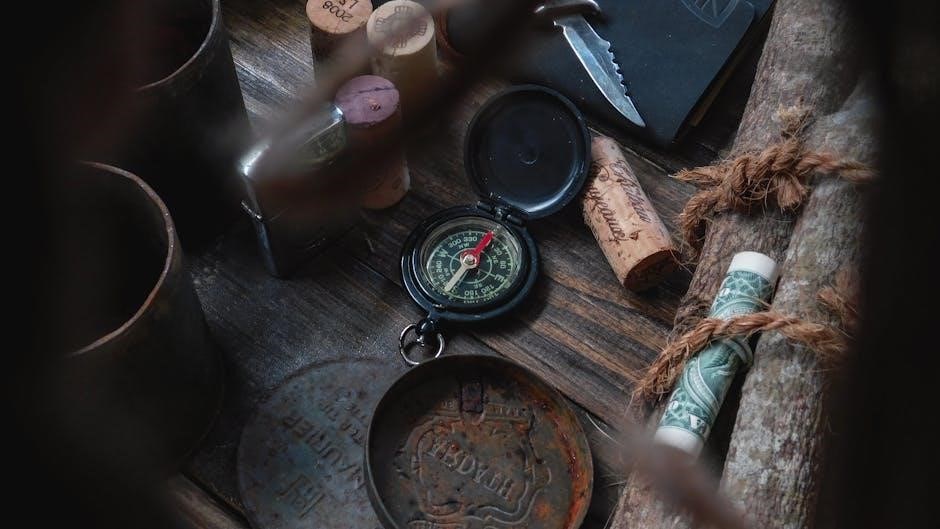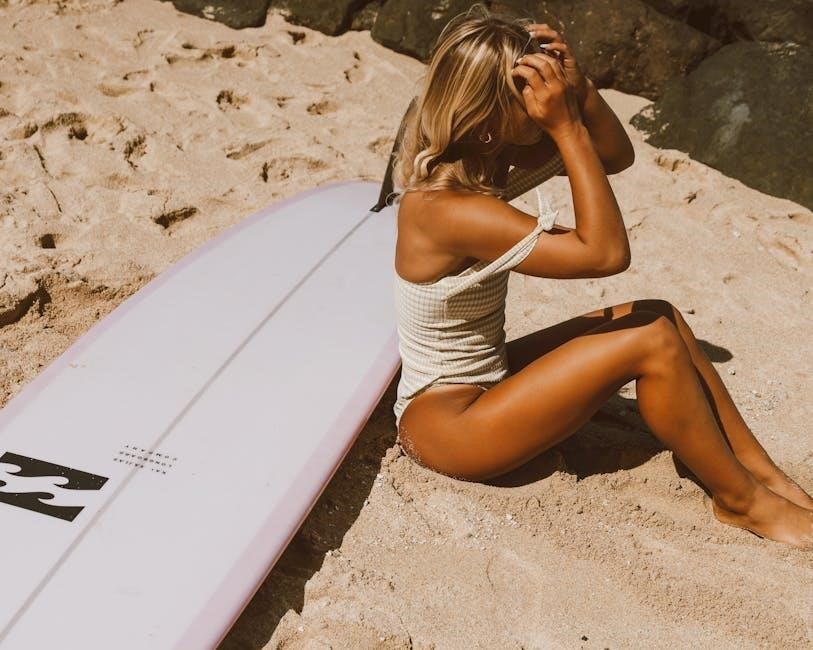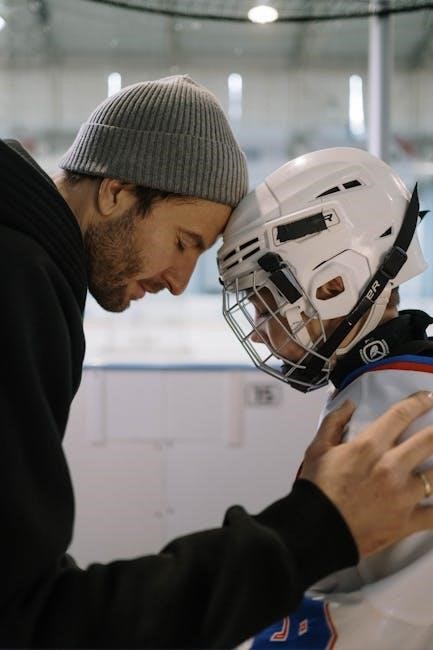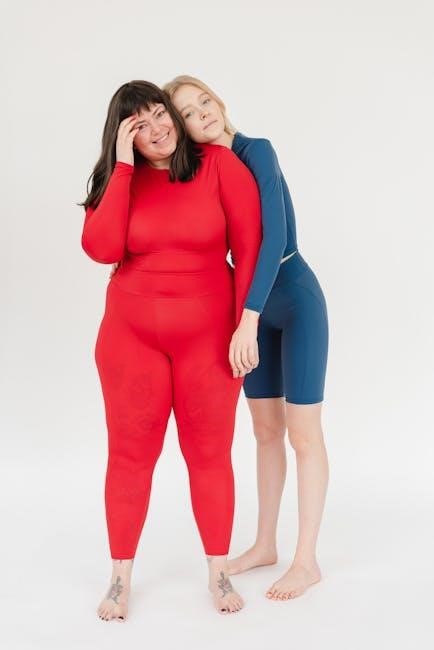Selecting the right bodyboard size is crucial for optimal performance, comfort, and control in the water․ The correct size ensures better wave catching and stability, making your experience more enjoyable․ Factors like height, weight, and skill level play a significant role in determining the ideal board size, which we will explore in detail․
1․1 Why Bodyboard Size Matters
Bodyboard size is essential for performance, comfort, and control․ The right size enhances wave catching and stability, making the experience enjoyable․ Factors like height, weight, and skill level influence the ideal board size, impacting buoyancy and maneuverability․ A larger person may need a bigger board for flotation, while a smaller person can manage with a smaller one․ Wave conditions also play a role; larger boards are better for small waves due to increased flotation, while smaller boards offer maneuverability in bigger waves․ Beginners benefit from larger, stable boards, whereas experienced riders prefer smaller boards for agility and tricks․ Personal preference, comfort, and control are also crucial, making size selection vital for mastering the sport․

Key Factors in Choosing the Right Bodyboard Size
Height, weight, experience level, and wave conditions are key factors in selecting the right bodyboard size․ These elements ensure optimal performance, comfort, and control in the water․
2․1 Height and Weight Considerations
Height and weight are critical factors in determining the ideal bodyboard size․ Generally, taller riders benefit from longer boards, while shorter individuals prefer shorter lengths for better control․ Weight plays a significant role in flotation, with heavier riders requiring thicker, more buoyant boards․ A common rule of thumb is to choose a board whose nose reaches your belly button when standing upright․ However, this can vary slightly based on your weight and riding style․ For instance, heavier riders might opt for a slightly longer board to enhance stability and buoyancy․ Conversely, lighter riders may prefer a shorter, more maneuverable option․ Balancing these elements ensures optimal performance and comfort in the water․
2․2 Importance of Experience Level
Your experience level significantly influences the choice of bodyboard size․ Beginners typically benefit from larger, more buoyant boards, which are easier to catch waves with and provide greater stability․ A larger board helps novices build confidence and improve their popping-up skills․ As riders gain experience and develop muscle memory, they can transition to smaller, more maneuverable boards that allow for tighter turns and advanced techniques․ Advanced riders often prefer narrower, high-performance templates for better control in challenging wave conditions․ Considering your skill level ensures you select a board that matches your abilities, enhancing both performance and enjoyment in the water․ This progression from larger to smaller boards is a common path for bodyboarders as they refine their skills over time․

Bodyboard Size Chart
A bodyboard size chart typically categorizes boards by height and weight ranges, helping riders select the optimal size for their needs and improving performance in the water․
3․1 Adult Bodyboard Size Recommendations
Adult bodyboard size recommendations are primarily based on height, weight, and riding experience․ Generally, taller riders (5’8″ and above) benefit from longer boards (41″-43″), while shorter riders (5’6″ and below) prefer shorter boards (39″-41″)․ Weight also plays a role, with heavier riders needing slightly larger boards for better flotation․ For small waves, a slightly bigger board (40″-42″) is recommended for easier catching and stability․ Experienced riders may opt for shorter boards (38″-40″) for maneuverability․ Personal preference and wave conditions should also guide the choice․ Most brands offer size charts tailored to these factors, ensuring the best fit for optimal performance and comfort in the water․
3․2 Child Bodyboard Size Recommendations
Choosing the right bodyboard size for children involves considering their height, weight, and skill level․ For kids under 4’8″, a 36″-38″ board is ideal, while those between 4’8″ and 5’2″ often prefer 38″-40″ boards․ Taller or heavier children may need slightly larger sizes for better buoyancy․ A general rule is to select a board that reaches approximately the child’s belly button when standing upright․ Lighter children may benefit from smaller boards for easier control, while heavier kids might need a bit more length for stability․ Wave conditions also play a role, with smaller waves requiring shorter boards․ Parents should consider their child’s growth and balance preferences when selecting the perfect size․ Consulting a detailed size chart or seeking advice from experienced riders can help ensure the best fit․

Wave Conditions and Their Impact on Bodyboard Size
Wave conditions significantly affect bodyboard size․ Smaller waves benefit from longer boards for flotation, while larger waves may require slightly shorter boards for better maneuverability and control․
4․1 Small Waves and Board Size
When riding small waves, choosing the right bodyboard size is essential for optimal performance․ A slightly larger board is often recommended for small waves, as it provides more flotation and makes it easier to catch waves․ This is especially important in mushier or weaker wave conditions, where buoyancy and speed are crucial․ A board with a bat tail is particularly beneficial in small waves, as it enhances flotation and allows for easier spinners and maneuvers․ Riders in small waves should opt for a board that reaches around their belly button or slightly longer, depending on their height and weight․ This ensures stability and control, making the experience more enjoyable and productive․
4․2 Large Waves and Board Size
Larger waves demand a different approach to bodyboard size․ In powerful, fast-moving waves, a slightly smaller or more streamlined board is often preferred․ This allows for better control and maneuverability, which are crucial in larger wave conditions․ A smaller board reduces drag, enabling quicker turns and tighter control, essential for navigating bigger waves effectively․ Additionally, a narrower tail shape can improve responsiveness, helping riders maintain stability and precision․ While personal preference plays a role, most riders find that a board slightly shorter than their belly button length works best for large waves․ Always consider wave conditions and your riding style when selecting a board size for larger waves to ensure optimal performance and safety․

Tail Shapes and Their Influence on Performance
Tail shapes significantly impact a bodyboard’s performance․ The bat tail enhances flotation and spinners, while other shapes offer unique benefits for control and maneuverability in various wave conditions․
5․1 Bat Tail for Flotation and Spinners
The bat tail is a popular choice for bodyboards due to its rounded shape, which provides increased flotation and stability․ This tail design is particularly effective in small waves, allowing riders to catch waves more easily and maintain control․ The bat tail also enhances spinners, making it easier to perform sharp turns and maneuvers․ Its wider surface area at the back of the board helps riders stay afloat and balanced, especially in choppy or whitewater conditions․ For beginners, the bat tail offers a forgiving platform to learn and improve, while advanced riders can leverage its responsiveness for intricate moves․ Overall, the bat tail strikes a balance between stability and performance, making it a versatile option for various wave conditions and skill levels․
5․2 Other Tail Shapes and Their Benefits
Beyond the bat tail, other tail shapes offer unique benefits tailored to specific riding styles and wave conditions․ The crescent tail is narrower, providing less drag and more maneuverability, ideal for advanced riders seeking speed and agility in larger waves․ The square tail delivers a balance between flotation and control, making it suitable for all-around use․ The pin tail, though less common, excels in hollow waves by reducing lift and enhancing drive․ Each tail shape influences how the board interacts with the water, affecting performance and responsiveness․ Riders should consider their preferred wave type and personal riding style when choosing a tail shape to optimize their bodyboarding experience and achieve better results in the water․

Advanced Bodyboard Size Considerations
Advanced riders often prioritize technical details like board thickness, core materials, and tail shapes for high-performance needs, ensuring optimal speed, control, and maneuverability in various wave conditions․
6․1 Technical Details for High-Performance Boards
For advanced riders, technical details like board thickness, core materials, and tail shapes significantly impact performance․ Thicker cores offer more flotation, while thinner boards provide better control․ Tail shapes, such as bat tails, enhance spinners and stability in small waves․ Advanced materials like carbon fiber improve durability and responsiveness․ Rider weight and wave conditions also influence these choices, with heavier riders benefiting from stiffer boards and lighter riders preferring more flexible options․ Customizing these aspects ensures optimal performance, making high-performance boards tailored to specific needs and riding styles․ Experts recommend considering these factors to maximize speed, maneuverability, and overall riding experience in challenging wave conditions․
6․2 Customizing Your Board for Specific Needs
Customizing your bodyboard can significantly enhance your riding experience by tailoring it to your specific needs․ Adjustments such as length, width, and tail shape can optimize performance for your height, weight, and riding style․ Riders in small waves may prefer a slightly longer board for better flotation, while those in large waves might opt for a shorter, more maneuverable design․ The core material and thickness can also be customized to suit your weight and preferences, with stiffer boards offering more control for heavier riders and softer boards providing flexibility for lighter riders․ Additionally, tail shapes like bat tails or crescent tails can be chosen based on your focus—whether it’s spinners, speed, or stability․ Expert customization ensures your board meets your unique requirements, balancing performance and comfort for unparalleled results in the water․
How to Choose the Right Bodyboard for Beginners
For beginners, selecting the right bodyboard size is essential for stability and ease of catching waves․ Start with a slightly larger board for better flotation and control, ensuring it matches your height and weight․ A bat tail shape is ideal for beginners, offering additional buoyancy and maneuverability․ This setup helps build confidence and skills in small waves, making the learning process more enjoyable and effective․
7․1 Starting with the Right Size for Beginners
For beginners, choosing the correct bodyboard size is essential to ensure stability, buoyancy, and ease of catching waves․ A board that is too small may lack flotation, while one that is too large can be difficult to control․ The ideal size for a beginner typically ranges between 40-42 inches for riders around 5’4″ and 100-140 lbs․ A general rule of thumb is to select a board that reaches your belly button when stood upright․ This size provides adequate flotation and maneuverability, allowing you to focus on learning proper techniques․ Starting with a slightly larger board also helps in smaller waves, where more volume is beneficial for catching and staying on the wave․ This approach ensures a more enjoyable and effective learning experience for new bodyboarders․
7․2 Transitioning to Advanced Sizes
As riders gain experience and improve their skills, transitioning to an advanced-sized bodyboard becomes necessary for optimal performance․ Advanced riders typically prefer shorter boards, ranging from 38-41 inches, which offer better maneuverability and control․ These boards are designed for higher-speed waves and allow for tighter turns and tricks․ Riders should consider their weight and height when sizing down, ensuring the board still provides sufficient flotation without compromising responsiveness․ Personal preference and wave conditions also play a role, with smaller boards excelling in larger, faster waves․ Customizing the board to fit specific needs can further enhance performance․ Transitioning gradually ensures a smooth adaptation to the new dynamics of a smaller, more agile board, allowing riders to push their limits and refine their techniques effectively․

The Role of Personal Preference in Selecting a Bodyboard
Personal preference significantly influences bodyboard selection, as riders prioritize styles, shapes, and sizes that align with their unique needs, riding style, and comfort in the water․
8․1 Riding Style and Board Size
Your riding style and preferences significantly impact the ideal bodyboard size․ For prone riders, a slightly shorter board enhances maneuverability, while drop-knee or stand-up riders may prefer longer boards for stability․ Riders focused on tricks and spins often opt for smaller, more responsive boards, whereas those prioritizing speed and flotation in small waves benefit from larger sizes․ Wave conditions also play a role, with larger boards excelling in heavy waves and smaller boards performing better in tight, hollow waves․ Personal preference dictates whether you value speed, control, or ease of use․ Beginners may lean toward larger boards for buoyancy, while experienced riders might choose smaller boards for agility․ Ultimately, matching your style to the right size ensures optimal performance and comfort in the water․
8․2 Comfort and Control Preferences
Comfort and control are key factors in selecting the right bodyboard size․ A board that feels too big may be difficult to manage, while one that’s too small can lack stability․ Riders seeking comfort often prefer a slightly longer board, allowing for better flotation and ease of paddling․ Control-oriented riders might opt for a shorter board, enabling sharper turns and quicker movements․ The width of the board also plays a role, with wider boards offering more stability and narrower boards providing better maneuverability․ Additionally, the nose and tail shapes can influence control, with bat tails enhancing grip and performance․ Balancing these elements ensures a bodyboard that suits both your riding style and personal comfort, making every session more enjoyable and effective․
Top Bodyboard Brands and Their Size Recommendations
Leading brands like NMD Bodyboards, Morey Boogie, and Blitz Surf Shop offer high-quality options with detailed size charts tailored to riders’ needs and preferences․
9․1 Leading Brands in the Market
Top bodyboard brands like NMD Bodyboards, designed by Nick Mesritz, and Morey Boogie, founded by Tom Morey, are renowned for their high-performance boards․ These brands prioritize innovation, durability, and rider-specific features․ Blitz Surf Shop is another trusted name, offering a wide range of boards tailored to different skill levels and wave conditions․ Leading brands often provide detailed size charts and customization options, ensuring riders find the perfect fit․ Their reputation for quality and performance makes them favorites among both beginners and advanced bodyboarders․ By choosing a reputable brand, riders can trust they are investing in a board that meets their needs and enhances their overall experience in the water․
9․2 Brand-Specific Size Charts
Leading brands like NMD Bodyboards and Morey Boogie provide detailed size charts tailored to their board designs․ These charts typically consider height, weight, and sometimes experience level to recommend the ideal board size․ For example, NMD Bodyboards offers a size guide based on height and weight, ensuring optimal performance and comfort․ Similarly, Blitz Surf Shop provides a range of boards with specific size recommendations to match individual rider needs․ These brand-specific charts often include additional factors like wave conditions and riding style, making them more precise than general size guides․ By following these charts, riders can select a board that aligns perfectly with their preferences and enhances their overall bodyboarding experience․

Additional Considerations for Bodyboard Sizing
Measuring yourself and considering personal riding style ensures the best fit․ Adjustments may be needed for taller or heavier riders to maintain performance and comfort․
10․1 Measuring Yourself for the Right Fit
Accurate measurements are essential for selecting the right bodyboard size․ Start by measuring your height and weight, as these are primary factors in determining your ideal board length․ Use a bodyboard size chart to match your height and weight to the recommended board size․ A common rule of thumb is to choose a board that reaches your belly button when stood upright․ For taller or heavier riders, a slightly longer board may be necessary to ensure adequate flotation and stability․ Additionally, consider your riding style and the type of waves you’ll be tackling, as these can influence the optimal size․ Personal preference plays a role, so it’s important to test different sizes if possible․ Always refer to brand-specific size guides, as they may vary slightly between manufacturers․
10․2 Common Mistakes to Avoid
When selecting a bodyboard, avoid common mistakes that can hinder performance and comfort․ One of the most frequent errors is ignoring height and weight guidelines, leading to a board that is either too small or too large․ Many riders also overlook wave conditions and their riding style, which significantly impact the ideal board size․ Additionally, guessing your size instead of using a size chart or brand-specific recommendations can result in a poor fit․ Another mistake is not considering personal comfort and control preferences, as these are crucial for an enjoyable experience․ Finally, some riders neglect to test different sizes before purchasing, which can lead to dissatisfaction․ By avoiding these pitfalls, you can ensure a better fit and improved performance in the water․

Maintenance and Care Tips
Regularly clean your bodyboard with mild soap and water to prevent damage․ Store it in a cool, dry place, avoiding direct sunlight and extreme temperatures to maintain its shape and performance․ Always check for dings or cracks and repair them promptly to extend its lifespan․ Proper care ensures your bodyboard remains durable and functional for years of enjoyable riding․
11․1 Extending the Longevity of Your Bodyboard
Proper maintenance is key to extending the life of your bodyboard․ After each use, rinse it with fresh water and mild soap to remove dirt and salt residue․ Avoid exposing your board to direct sunlight for extended periods, as it can cause the core to delaminate․ Store it in a cool, dry place, away from extreme temperatures․ Regularly inspect for dings or cracks and repair them immediately to prevent further damage․ Use a protective bag during transport to shield it from impacts․ By following these care tips, you can ensure your bodyboard remains in great condition, maintaining its performance and longevity for years of enjoyable riding․

Expert Tips for Getting the Most Out of Your Bodyboard
Always match your bodyboard size to your weight and height, and consider wave conditions for optimal performance․ Regularly check and maintain your board for longevity․
12․1 Optimizing Performance with the Right Size
Choosing the correct bodyboard size is essential for maximizing performance in the water․ A board that matches your height, weight, and skill level ensures better control and maneuverability․ For smaller waves, a slightly larger board provides more flotation, making it easier to catch waves․ Conversely, in larger waves, a smaller, more responsive board allows for sharper turns and faster acceleration․ Experienced riders often prefer boards tailored to specific wave conditions, while beginners benefit from a versatile size that adapts to various situations․ Additionally, measuring the board against your body—such as ensuring the nose reaches your belly button—can help optimize fit and performance․ This balance ensures you get the most out of every session․
Selecting the right bodyboard size is a cornerstone of an enjoyable and successful bodyboarding experience․ By considering factors like height, weight, skill level, and wave conditions, riders can optimize performance and comfort․ Whether you’re a beginner or an advanced rider, understanding the importance of proper sizing ensures better control, maneuverability, and overall enjoyment in the water․ Remember, the right size enhances your ability to catch waves and ride confidently․ Always measure carefully, consider personal preferences, and adapt to different conditions for the best results․ With the right board, you’ll be ready to embrace the waves and make the most of your time in the ocean․